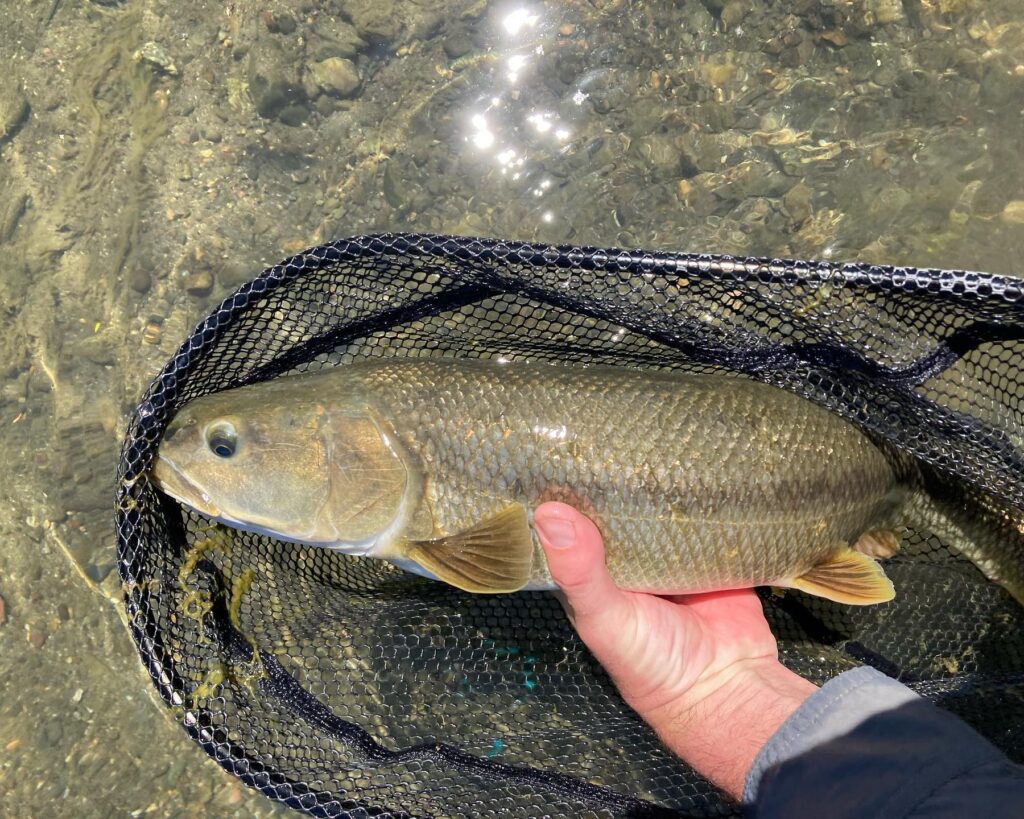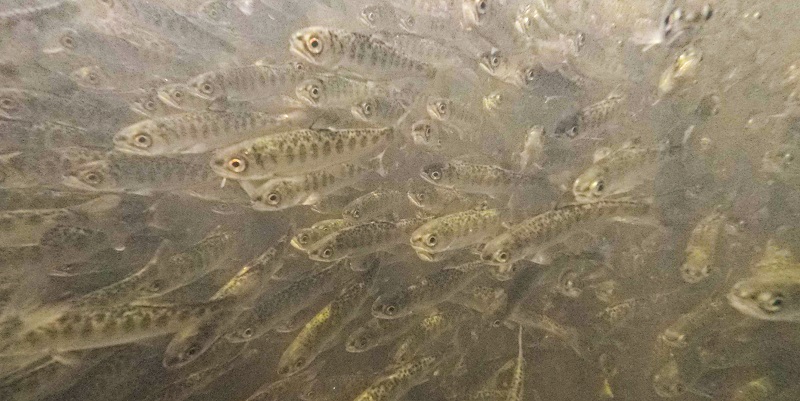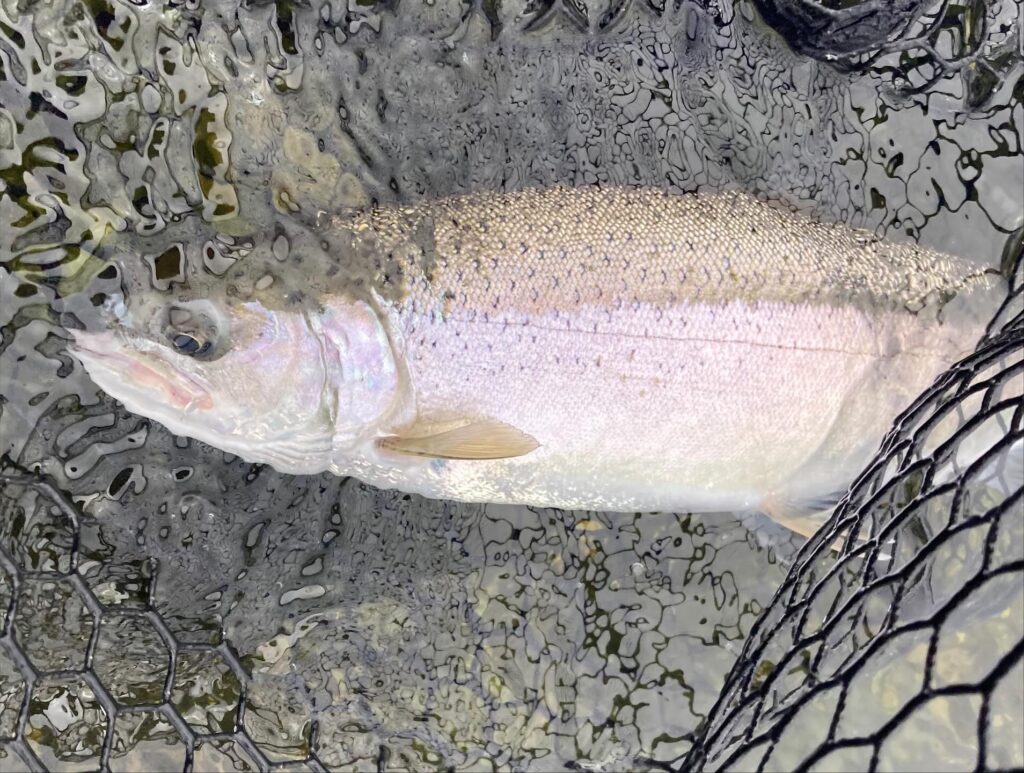In late August, I gave California Trout’s 2025 Eel River Pikeminnow Fishing Derby a shot. Sadly, I did not win the Derby. But I did come across a number of conditions that got me thinking about rearing juvenile salmonids.
For starters, I caught and observed large Sacramento pikeminnow that appeared to be feeding very well in the summer’s warm water temperatures. Depending on where I placed my thermometer in the water column, the temperatures in the South Fork Eel River ranged between the low and the high 70s. Any juvenile salmonid that had options would be nowhere near these conditions.

Sacramento pikeminnow in 2025. Image: Eric Woodruff
That begs the question, where do juvenile salmon and steelhead go? Also, what do they do as they grow and begin their downstream migration to the open waters of the Pacific Ocean? One of the strategies appears to be to avoid the mainstem Eel River and the forks of the Eel River. The fish remain in the tributaries of the Eel River as long as those tributary habitats are available.
If they enter the Eel River and its forks during the hot summer months, rearing juvenile steelhead seek out areas of the river where colder water is present. Such spots are called thermal refugia. Riverine systems tend to contain a number of thermal refugia.
Common locations for thermal refugia include the confluences with colder-running tributaries, areas with groundwater or spring inflows, stratified pools, and areas where some of the river’s flow moves sub-surface through gravel. Thermal refugia offer necessary relief during the hottest times of the year. Previous rearing studies point to areas in the upper mainstem of the Eel River between Tomki and Outlet creeks. Additionally, stratified pools near Fish Creek regularly hold rearing juvenile steelhead. (EPA, 2004).

Juvenile Chinook salmon swim in a raceway at Iron Fish Gate Hatchery, Siskiyou County, Calif., before their relocation to the Fall Creek facility on July 7, 2021. Image: California Department of Fish and Wildlife and Travis VanZant
Chinook salmon juveniles generally do not rear in freshwater during summer months. This means the summer water temperatures of the upper mainstem of the Eel River are not generally relevant to Chinook. (EPA, 2004). Past CDFW studies indicate that juvenile Chinook and coho salmon rear throughout the summer in the Eel River estuary and McNulty Slough. (CDFW, 2013). These waterways provide brackish water for juvenile fish before the fish migrate out to the Pacific Ocean. CDFW observed juvenile steelhead in these waters when the fish were in the smolt life stage. Estuary waters remain cooler in summer months due to coastal influence and cooler ambient temperatures.
Predation and competition continue to have negative impacts on Eel River salmonid populations. Sacramento pikeminnow introduced to the Eel River system in the early 1980s are reducing the potential for natural populations of steelhead and salmon throughout the entire watershed. (Yoshiyama & Moyle, 2010). Furthermore, larger salmonids are known to feed on smaller juveniles.
Juveniles navigate the gauntlet of predation in a number of ways. The first is to stay in tributaries to the Eel River and its forks. Broadly speaking, pikeminnow are less likely to access tributary habitats than the mainstem Eel River and the forks of the Eel River.
Salmonids often migrate at night. This lessens the probability of being hunted by other fish, raptors, and mammals. Another tactic is to engage in a behavior called ”predator swamping,” which involves migrating in large schools so that some escape predators. Further, salmonids seek shelter along river banks during the day. They tend to utilize flood plains for protection and food abundance, to slow their migration speed in the shade, and speed up in the sun to evade predators.
It is difficult to not be worried about the fate of salmonid populations in all of California’s anadromous river systems. My temperature readings from the South Fork Eel River were very concerning. Yet reviewing the facts about salmonids’ strategies is a reminder that the fish have multiple options to lessen the rate of predation.
Looking ahead, the expected removal of the Scott Dam in Lake County and the Cape Horn Dam in Mendocino County will be beneficial. The removal of these structures will increase access to high elevation areas in the upper mainstem Eel River that have cooler water temperatures in the summer. These higher elevation reaches are also likely to be inaccessible to pikeminnow. This contrasts with Lake Pillsbury, which is a vector for Sacramento pikeminnow and their propagation.

A coastal steelhead trout in 2025. Image: Eric Woodruff
References
https://19january2021snapshot.epa.gov/sites/static/files/documents/uer-tmdl-final-12-28.pdf
https://www.colorado.edu/today/2025/02/21/how-young-salmon-navigate-gauntlet-danger-en-route-sea
